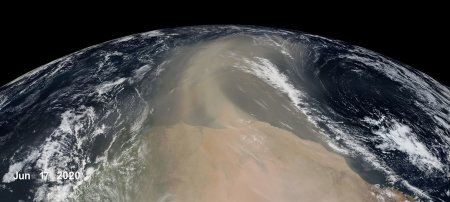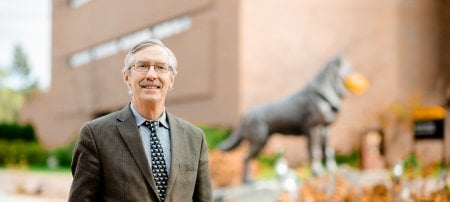There’s more to nitrogen than the letter N. The element and its biogeochemical cycle is the focus of research by Amy Marcarelli, an associate professor of biological sciences. Last year, Marcarelli won a National Science Foundation (NSF) Early Career Award grant to explore two halves of the nitrogen cycle. Her work could flip how we currently think about the nitrogen cycle.
In the nitrogen cycle, the balance of nitrogen fixation and denitrification is not a perfect yin-yang. Unbalanced systems can lead to more than just August pond scum; excess nitrogen is the main driver of the world's dead zones at major river deltas. Marcarelli's research, funded by an NSF CAREER grant, dives into the unexplored side of nitrogen fixation in streams.
Learn more about Marcarelli's research in a few ways:
- Join @mturesearch Thursday March 17 from 1 to 2 p.m. Eastern for a live chat with @AmyMarcarelli. Follow #mtulive to see the conversation.
- Don’t worry if you missed the live chat—check out the Storify below.
- We also break down the yin and yang of nitrogen fixation and denitrification in an infographic.
- For even more, listen to Marcarelli explain her research with Allison Mills in the video below, with illustrations by Jordan Blahnik and produced by Ben Jaszczak. (Check out the too long; didn't read version up top)
Then, stay tuned this summer as Marcarelli and her research team make their way across North America to measure streams from Puerto Rico to Michigan to Idaho to Alaska. They'll be taking a van that is currently in the shop with a team of mechanical engineering seniors, who transforming it for their senior design project into a transportable ecology lab and classroom. Watch for updates on @mturesearch and #FieldworkFriday.

Amy Marcarelli: Denitrification Career Award
Nitrogen Fixation Infographic
The infographic below explains how nitrogen fixation and denitrification are like a yin-yang. Most of the time, we think the processes balance each other out. However, Marcarelli's research focuses on the fact that nitrogen fixation is rarely measured in streams; that means we're missing an entire half of that yin-yang. Plus, from other studies on lake environments, we know that nitrogen limitation—a cap on how much nitrogen is available for organisms—is influenced by the availability of other nutrients, notably phosphorus.
Yin-Yang of Nitrogen: #NSFCareer Researcher Amy Marcarelli
The balance of nitrogen fixation and denitrification is not a perfect yin-yang. Unbalanced systems can lead to more than just August pond scum; excess nitrogen is the main driver of the world's dead zones at major river deltas.Amy Marcarelli's research, funded by an NSF CAREER grant, dives into the unexplored side of nitrogen fixation in stream
Over the next summer, @AmyMarcarelli will be leading a team across North America, gathering samples in streams from Puerto Rico to Alaska to get a better sense of nitrogen fixation. Stay tuned on @mturesearch and mtu.edu/unscripted to learn about the team's work. Here's a local stream where they'll sample.
This is a recap of a live chat with @AmyMarcarelli and @mturesearch from March 17, 2016.This is one of the streams where @AmyMarcarelli does her #NSFCAREER work. #mtulive #nitrogen #ecology pic.twitter.com/jGJqBJqJuB
— MTU Research (@mturesearch) March 17, 2016
This is Hills Creek, on #michiganskeweenaw #PureMichigan https://t.co/wQ5r5owiKY
— Amy Marcarelli (@AmyMarcarelli) March 17, 2016
Meet the Processes
@AmyMarcarelli's work focuses on two processes in the nitrogen cycle: nitrogen fixation and denitrification. In undisturbed natural ecosystems, the processes balance each other out, with each part of the cycle driven by certain microbial communities. In a nutshell: nitrogen gas gets converted (via nitrogen fixation) into a new form of nitrogen (ammonium), which is transformed into another kind (nitrate), and is finally changed again and released back into the atmosphere (via denitrification.)
Here is a quick explainer:
The Balancing Act
Within this big global biogeochemical cycle, @AmyMarcarelli is interested in how nitrogen fixation and denitrification are balanced.
@mturesearch at the global scale, we think they should be closely balanced, or that denitrification should be slightly higher #mtulive
— Amy Marcarelli (@AmyMarcarelli) March 17, 2016
@mturesearch The problem is that humans have doubled the amount of N cycling globally, which may disrupt the balance pic.twitter.com/02DcfDAXXH
— Amy Marcarelli (@AmyMarcarelli) March 17, 2016
@mturesearch In lakes, estuaries and rivers, we know that denitrification can increase substantially as N loads increase
— Amy Marcarelli (@AmyMarcarelli) March 17, 2016
@mturesearch What happens to N fixation is less clear - that’s what we’re interested in, along with @fulweilerlab @ScottBiogeochem & others
— Amy Marcarelli (@AmyMarcarelli) March 17, 2016
@mturesearch These are colonies of Nostoc, which are common in our Idaho study streams
— Amy Marcarelli (@AmyMarcarelli) March 17, 2016
@mturesearch I'm most interested in cyanobacteria, who are big nitrogen fixers in many streams pic.twitter.com/b3rvR171qO
— Amy Marcarelli (@AmyMarcarelli) March 17, 2016
@mturesearch (1/2) We don’t have enough data from streams and rivers to understand the balance between #Nfixation and denitrification.
— Amy Marcarelli (@AmyMarcarelli) March 17, 2016
@mturesearch (2/2) Part of the goal of our #NSFCAREER project is to fill this data gap @NSF_BIO #basicscience
— Amy Marcarelli (@AmyMarcarelli) March 17, 2016
The Other players
Nitrogen is a major nutrient that organisms need to survive. However, it's not the only nutrient.
@MichiganTechBio Organisms use many nutrients, and if the load of others, like #phosphorus, are also high, then organisms may stay N limited
— Amy Marcarelli (@AmyMarcarelli) March 17, 2016
DNF also increases with P enrichment in lakes-can this happen in streams?https://t.co/375wVo8Qwr @AmyMarcarelli @bobsterner
— Thad Scott (@ScottBiogeochem) March 17, 2016
@ScottBiogeochem Great q! I don't think we understand well how P changes DNF in streams - planning nutrient enrichment exp in yrs 2-3.
— Amy Marcarelli (@AmyMarcarelli) March 17, 2016
#mtulive @AmyMarcarelli describe the streams you work on. Is N usually a limiting nutrient in those streams? @mturesearch @NSF_BIO
— Biological Sciences (@MichiganTechBio) March 17, 2016
@MichiganTechBio #Nfixation should be favored when N is limiting - a big question is whether increasing N loads changes nutrient limitation
— Amy Marcarelli (@AmyMarcarelli) March 17, 2016
.@jessienam #mtulive how about this from https://t.co/49JwAFt15t @mturesearch @AmyMarcarelli pic.twitter.com/a1mDPHo7Gg
— Biological Sciences (@MichiganTechBio) March 17, 2016
Summer Streams
Hard to imagine with this picture, but in the summer, the van below will be an ecology powerhouse. Right now a group of @mtuMEEM students are giving the vehicle a make-over to turn it into a transportable lab and classroom.
@mturesearch We'll be on the road in our new Mobile Lab, being built in this van by a @mtuMEEM Senior Design team! pic.twitter.com/4uPmW7lHZm
— Amy Marcarelli (@AmyMarcarelli) March 17, 2016
@mturesearch We'll be continuing field work here in MI and also in the Portneuf River in ID with collaborator Colden Baxter @IdahoStateU
— Amy Marcarelli (@AmyMarcarelli) March 17, 2016
@mturesearch We're also going to be characterizing #microbial communities in our streams with new faculty Steve Techtmann @MichiganTechBio
— Amy Marcarelli (@AmyMarcarelli) March 17, 2016
And all that travel is guaranteed to be better than this:
Hey @mabakerusu, remember this? #Fieldworkfail #Backcountryfieldwork https://t.co/q89CttbqFV
— Amy Marcarelli (@AmyMarcarelli) March 17, 2016
Michigan Technological University is an R1 public research university founded in 1885 in Houghton, and is home to nearly 7,500 students from more than 60 countries around the world. Consistently ranked among the best universities in the country for return on investment, Michigan's flagship technological university offers more than 185 undergraduate and graduate degree programs in science and technology, engineering, computing, forestry, business, health professions, humanities, mathematics, social sciences, and the arts. The rural campus is situated just miles from Lake Superior in Michigan's Upper Peninsula, offering year-round opportunities for outdoor adventure.







Comments